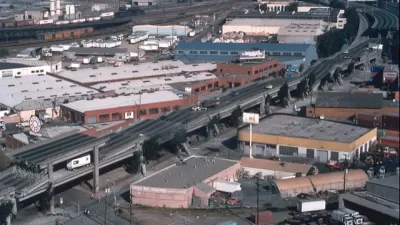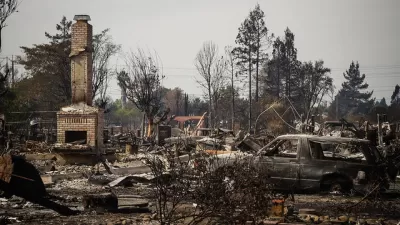Cities like San Francisco and Los Angeles already keep lists of vulnerable buildings, but a new piece of legislation would require all California cities do the same. The catch? The bill will not provide funding to support these lists.

Experts can spot certain tell-tale signs of earthquake vulnerability right away, but for those who aren't experts it can be harder to identify possibly dangerous buildings. "Now the Legislature has sent to Gov. Jerry Brown a bill that would require cities and counties in the state’s most seismically vulnerable areas to create lists of buildings that could be at higher risk of major damage or collapse," Rong-Gong LIN II writes for the Los Angeles Times.
Those opposed to the bill point out that it creates no provision for funding the creation of this list. "But backers of the bill say creating a list of possibly vulnerable buildings would represent a major step in alerting Californians whether the buildings in which they live and work should receive more study to determine whether they’re at risk in an earthquake," Lin writes. Representatives from cities like San Francisco and Los Angeles, who already maintain this type of list, say it's irresponsible for cities likely to be affected by seismic activity not to alert their citizens of the risks they face. How much would that cost? "Rough estimates published by legislative staffers say that while amounts are uncertain, costs that might need reimbursement by the state could be in the tens of millions of dollars to create an inventory by 2021, with a total possibly exceeding $100 million," Lin reports.
FULL STORY: Fearing massive earthquake, California considers requiring lists of buildings most likely to collapse

Alabama: Trump Terminates Settlements for Black Communities Harmed By Raw Sewage
Trump deemed the landmark civil rights agreement “illegal DEI and environmental justice policy.”

Study: Maui’s Plan to Convert Vacation Rentals to Long-Term Housing Could Cause Nearly $1 Billion Economic Loss
The plan would reduce visitor accommodation by 25% resulting in 1,900 jobs lost.

Why Should We Subsidize Public Transportation?
Many public transit agencies face financial stress due to rising costs, declining fare revenue, and declining subsidies. Transit advocates must provide a strong business case for increasing public transit funding.

Paris Bike Boom Leads to Steep Drop in Air Pollution
The French city’s air quality has improved dramatically in the past 20 years, coinciding with a growth in cycling.

Why Housing Costs More to Build in California Than in Texas
Hard costs like labor and materials combined with ‘soft’ costs such as permitting make building in the San Francisco Bay Area almost three times as costly as in Texas cities.

San Diego County Sees a Rise in Urban Coyotes
San Diego County experiences a rise in urban coyotes, as sightings become prevalent throughout its urban neighbourhoods and surrounding areas.
Urban Design for Planners 1: Software Tools
This six-course series explores essential urban design concepts using open source software and equips planners with the tools they need to participate fully in the urban design process.
Planning for Universal Design
Learn the tools for implementing Universal Design in planning regulations.
Smith Gee Studio
Alamo Area Metropolitan Planning Organization
City of Santa Clarita
Institute for Housing and Urban Development Studies (IHS)
City of Grandview
Harvard GSD Executive Education
Toledo-Lucas County Plan Commissions
Salt Lake City
NYU Wagner Graduate School of Public Service




























